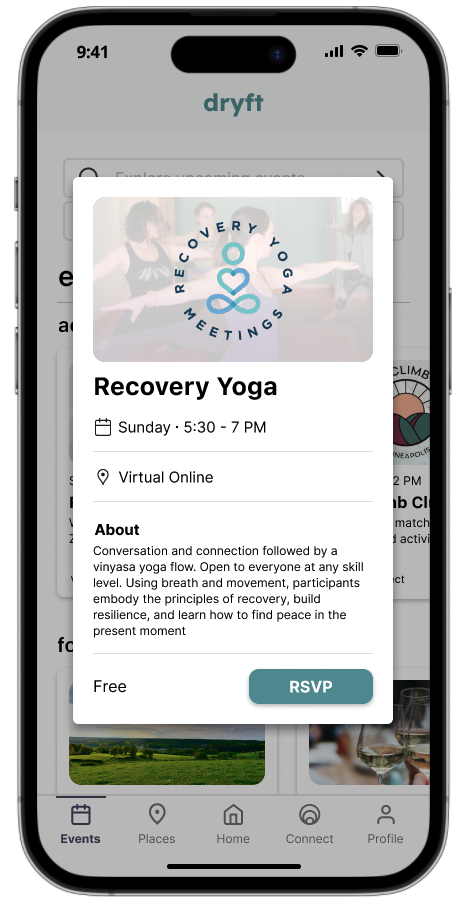dryft
Design Conceptualization & Prototyping
dryft is a mobile app designed to empower individuals in their journey toward sobriety by centralizing supportive, active, and social events within the recovery community in the Twin Cities.
MY ROLE
UX Researcher
UX/UI Designer
Usability Test Moderator
METHODS
Secondary Research | Competitive/Comparator Analysis | User Surveys | Love Letter/Break-Up Letter | Affinity Diagramming | User Journey Mapping | Mid-Fidelity Prototyping | Usability Testing | Information Architecture Diagramming | High-Fidelity Interactive Prototyping
Executive Summary
Deliverables:
Interactive Prototype
Video Walkthrough
Dryft is a mobile app prototype designed to help sober and sober-curious individuals in the Twin Cities discover alcohol-free events and inclusive community spaces — without relying on AA meetings or 12-step programs. While sobriety-focused apps often emphasize recovery tracking or peer support, Dryft focuses on building a new sober social network. Through user research, persona development, rapid prototyping, and usability testing, I designed a solution that empowers users to explore meaningful, welcoming, and alcohol-free spaces - without needing to identify with formal recovery programs.
The Problem
People in early sobriety or exploring a sober lifestyle often feel isolated from social life, especially when events revolve around alcohol or formal recovery programs. Many crave casual, community-based alternatives that make it easy to find connection without pressure, labels, or explanation. Individuals want to feel welcome, safe, and seen.
Key Challenges
Limited Discoverability: Alcohol-free events are spread across social platforms and hard to track down without word-of-mouth.
Social Disconnection: Many users feel left out of their local social scenes due to the normalization of alcohol use.
Lack of Inclusive Language: Recovery culture often feels prescriptive or clinical; many users want community without needing to justify their lifestyle.
How might we design a mobile app that helps users easily discover inclusive, engaging, alcohol-free events — without needing to identify with a recovery program?
The Process
User Research
I conducted user interviews with individuals who were newly sober, sober-curious, or in long-term recovery, along with interviews with local event organizers who host alcohol-free or wellness-based gatherings.
Key Insights
Users want more than just support groups — they want fun, creativity, movement, and connection.
Events were often discovered through word-of-mouth or niche Instagram accounts.
The emotional tone of an event (welcoming, casual, non-judgmental) was more important than the activity itself.
Pivot Moment:
I initially assumed users were looking to replace AA entirely — but I discovered that many valued the structure and support of AA, while still craving a more expansive, everyday sense of connection outside of formal meetings. This insight shifted the project’s direction toward designing for social enrichment, not just recovery support.
Ideation & Wireframing
I focused on helping users find events based on:
Type of activity (creative, movement-based, educational, wellness)
Emotional environment (calm, casual, energizing, community-focused)
Accessibility (location, cost, physical access)
Initial sketches explored simple search and filter flows, event tagging systems, and the ability to save or share events.
Usability Testing
I tested a mid-fidelity prototype with 6 users who represented a range of sober identities and lifestyles.
Findings
100% of testers easily found events that matched their preferences
Users appreciated clear labels such as “alcohol-free confirmed” or “community-centered”
2 testers suggested more detail on what to expect at each event (size, activities, tone)
“I hope projects like this app will help our communities 1) be aware of other recovery models, and 2) help people become more accepting of other ways than just the 12-step model. ”
Final Design Highlights
Interactive Prototype Walkthrough
The final prototype focused on making it easy for users to discover, evaluate, and share alcohol-free events that align with their personal interests and social needs. Each feature was designed to reduce friction, promote confidence in attending new spaces, and support users in building a fulfilling sober lifestyle — without relying on formal recovery settings.
Flexible Search Filters: Browse by category, day, neighborhood, and emotional tone
Event Detail Cards: Include host notes, attendance expectations, and accessibility details
Save & Share Tools: Users can bookmark events or share them with friends in-app
Connection Hub: Users can post audio and text messages, sharing their story and the reason why they are staying sober for today.
Outcomes
Reflections
All users reported that the app would reduce social friction in their sober journey
95% said they would recommend the app to a friend
Several mentioned they had never seen this type of tool before and felt hopeful about using it to connect
Dryft showed me that emotional accessibility matters just as much as physical accessibility. Users weren’t just looking for things to do — they were searching for places where they didn’t have to explain themselves. Small details like how we frame event tone or what we call a category can deeply impact inclusion and trust.
Next Steps
To expand Dryft further I would:
Build out an organizer dashboard for event submissions
Develop a user referral program to grow sober-friendly communities
Partner with nonprofits and wellness spaces for trusted event sourcing
Incorporate more tags for events: I would introduced event tags like “Quiet & Reflective,” “Creative & Hands-on,” and “Peer-Led” to help users anticipate the emotional feel of an event before attending.
Key Learnings & Challenges
Designing for sobriety required more than avoiding alcohol-related content — it meant creating emotionally safe spaces that didn’t feel clinical or overly structured.
Many users found value in AA but wanted a more casual, joyful way to connect socially — reinforcing that good design can complement existing systems rather than replace them.
Talking with users about deeply personal experiences challenged me to be a more empathetic and intentional researcher — and showed me how critical language and tone are in fostering trust.






